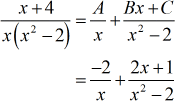How to Perform Partial Fraction Decomposition or Expansion
This method is used to decompose a given rational expression into simpler fractions. In other words, if I am given a single complicated fraction, my goal is to break it down into a series of “smaller” components or parts.
Previously on adding/subtracting rational expressions, we want to combine two or more rational expressions into a single fraction just like the example below. However, partial fraction decomposition (also known as partial fraction expansion) is precisely the reverse process of that. The following is an illustrative diagram to show the main concept.
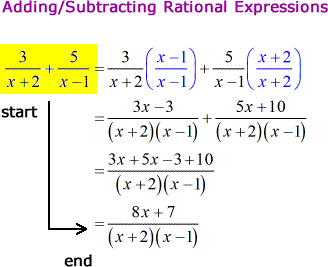
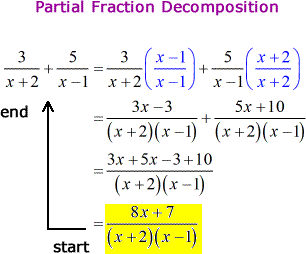
Now, I will go over five (5) examples to demonstrate the steps involved in decomposing a single fraction into parts.
Examples of How to Decompose Partial Fractions
Example 1: Find the partial fraction decomposition of the rational expression.

This problem is easy, so think of this as an introductory example. I will start by factoring the denominator (take out [latex]x[/latex] from the binomial). Next, I will set up the decomposition process by placing [latex]A[/latex] and [latex]B[/latex] for each of the unique or distinct linear factors. The subsequent steps then involve getting rid of all the denominators by multiplying the [latex]LCD[/latex] (which is just the original denominator of the problem) throughout the entire equation.
I should end up with a simple equation where I can easily compare the coefficients of similar terms from both sides of the equation. As a result, I will get a system of linear equations with variables [latex]A[/latex] and [latex]B[/latex] that can be solved by either the Substitution Method or Elimination Method, whichever I prefer.
- Given the fraction

- Factor out the denominator.

- Create individual fractions on the right side having each of the factors acting as the denominator. I have two partial fractions here with two unknown values of numerators represented by variables [latex]A[/latex] and [latex]B[/latex].

- I want to eliminate all the denominators. It can be done by multiplying both sides of the equation by the [latex]\color{blue}LCD = x\left( {x + 1} \right)[/latex].

- Next, I distribute the [latex]LCD[/latex] to each side of the equation. At this stage, I try to be very careful in keeping track of the cancellation process. I want to make sure that I get this step right to prevent any unnecessary headaches later.

- This is the simplified equation after doing the above step correctly.

- Now, I will multiply things out and collect common terms by writing them side by side. It’s time to compare the coefficients of the polynomials. The idea is to equate the corresponding coefficients of similar terms.
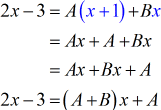
- I equate the coefficients of the [latex]x-[/latex]term emphasized by the yellow highlight. In addition, I equate the constant terms as shown by the green highlight.

- I then arrive at solving two equations with two unknowns. Use the Substitution Method to solve for [latex]B[/latex].

- These are the final values of variables [latex]A[/latex] and [latex]B[/latex].

- Plug in the solved values of [latex]A[/latex] and [latex]B[/latex] back into the original setup to get the final answer.

Example 2: Find the partial fraction decomposition of the rational expression.

This problem is similar to example 1. The only difference is that the factors of the denominator are two linear binomials.
- Given the problem

- I start by factoring out the trinomial in the denominator.
Then, I setup up the partial fraction decomposition by putting [latex]A[/latex] and [latex]B[/latex] as numerators. The two distinct linear factors will take the position of the denominators.

- I want to eliminate all the denominators so I will multiply both sides of the equation by the [latex]LCD[/latex] (in blue).

- I need to be careful when canceling common factors.

- The steps here are pretty much part of the “cleaning up” process and reorganization of common terms.

- It’s time to create the correspondence between the two sides of the equation.
For the [latex]x[/latex] terms, the coefficients [latex]\left( {A + B} \right) = 1[/latex] while the pure numbers I have [latex]3A + 5B = – 1[/latex].

- We have two equations with two unknowns. From this point forward, it should be easy to handle, right? I suggest we use the Elimination Method to solve for [latex]A[/latex] and [latex]B[/latex].
Multiply the top equation by either [latex] – \,3[/latex] or [latex] – \,5[/latex] then add them together to eliminate one of the variables.

- These are the correct values of [latex]A[/latex] and [latex]B[/latex].

- I will come back to the original setup of the partial fractions to replace the values of [latex]A[/latex] and [latex]B[/latex] with actual numbers.

Example 3: Find the partial fraction decomposition of the rational expression

In this problem, the denominator is the product of a distinct linear factor which is repeated three times denoted by the exponent [latex]3[/latex]. Don’t commit the error of writing three partial fractions with a common denominator of just [latex]\left( {x – 1} \right)[/latex]. That is not correct.
Instead, think of three possibilities on how the denominator may look like after solving it. Possible denominators include [latex]\left( {x – 1} \right)[/latex], [latex]{\left( {x – 1} \right)^2}[/latex], and [latex]{\left( {x – 1} \right)^3}[/latex].
- Given the fraction

- Since I have a repeated linear factor [latex]\left( {x – 1} \right)[/latex] raised to the power of [latex]3[/latex], I need to account for each power starting from lowest (1) to highest (3).

Do you see why this setup is wrong?
Hint: Add the partial fractions then compare their denominators.
- Remove all the denominators by distributing the [latex]LCD[/latex] into the equation.


- This is the simplified version after the cancellations of common factors.

- Like in our previous problem, I will distribute [latex]A[/latex] and [latex]B[/latex] into the parenthesis. Then, rearrange them in such a way that similar terms are side-by-side.
Finally, I’ll group the [latex]x^2[/latex], [latex]x[/latex], and “constant” coefficients together.
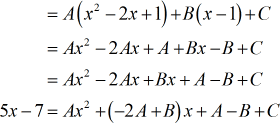
- Use arrows, if necessary, to create correspondence among coefficients of similar terms.

I introduced a zero placeholder to the missing [latex]x^2[/latex] term on the left side. This is a very critical step.
- Now, I can clearly extract the required equations that will be used to solve for the missing variables.
The equation [latex]A = 0[/latex] is a nice freebie since I don’t have to sweat solving for it algebraically.

- Use the fact that [latex]A = 0[/latex], plug that to the second equation [latex]\left( { – 2A + B = 5} \right)[/latex] to get [latex]B[/latex]. Finally, solve for [latex]C[/latex] using the third equation using the solved values of [latex]A[/latex] and [latex]B[/latex].

Did you get the same answers?
- Write down the original setup of partial fraction decomposition, and replace the solved values for [latex]A[/latex], [latex]B[/latex], and [latex]C[/latex].
The fraction where the numerator is [latex]A = 0[/latex] will disappear. This leaves us with two fractions as the final answer.
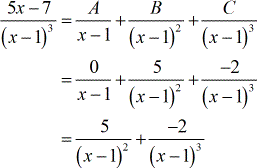
Example 4: Find the partial fraction decomposition of the rational expression

This is the case where the denominator is a product of distinct linear factors where some are repeated.
Notice that the denominator of this rational expression is composed of two distinct linear factors. The first one is [latex]\left( {x – 2} \right)[/latex] which appears once, while the second factor is [latex]\left( {x – 3} \right)[/latex] appears twice, thus repeated.
- Given the fraction

- I have two distinct linear factors here.
[latex]\left( {x – 2} \right)[/latex] appears once
[latex]\left( {x – 3} \right)[/latex] appears twice denoted by the power [latex]2[/latex]
Therefore, I will write [latex]\left( {x – 2} \right)[/latex] in one partial faction, while [latex]\left( {x – 3} \right)[/latex] in two partial fractions with increasing exponents from [latex]1[/latex] to [latex]2[/latex].

- I will eliminate all denominators by multiplying the equation with the respective [latex]LCD[/latex].

- Again, I have to be careful with my cancellations.

- You might say that this looks “horrible” at the surface. However, if you look at each step patiently, you should realize that it’s not that bad.
I simply distribute [latex]A[/latex], [latex]B[/latex], and [latex]C[/latex] into the parenthesis. Then, rearrange them so that similar terms are adjacent to each other.
Finally, I’ll group the coefficients of [latex]x^2[/latex], [latex]x[/latex], and “constant” terms together.
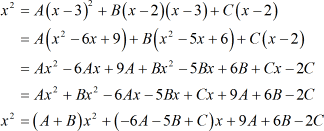
- Only the left side has the [latex]x^2[/latex] term. This means I must provide zero placeholders for the missing [latex]x[/latex] term and the constant term.
By doing so, it becomes easy to compare the coefficients of similar terms on both sides of the equation.
The arrows and color coding should guide you with this process.

- I can solve this in several ways. One way is to use the Elimination Method to get rid of [latex]C[/latex] between the 2nd and 3rd equations.
I will multiply the 2nd equation by [latex]2[/latex] then add that to the 3rd equation. I should end up with an equation containing [latex]A[/latex] and [latex]B[/latex] only. Use this “new” equation with the 1st equation to solve for the values of [latex]A[/latex] and [latex]B[/latex]. I suggest that you try it on paper so you can follow it.
Once you get the values of [latex]A[/latex] and [latex]B[/latex], you can solve for [latex]C[/latex] using either of the 2nd or 3rd equation using back-substitution.

- These are the correct values of [latex]A[/latex], [latex]B[/latex], and [latex]C[/latex].

- Substitute the values into the original partial fraction setup to obtain the final answer.

Example 5: Find the partial fraction decomposition of the rational expression

This is another type of problem in partial fraction decomposition. Factoring the denominator, I get the following.
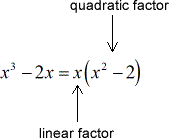
Notice that this time around I have a quadratic factor. The question is, can I still factor it out further into linear terms? I can try, but it’s obvious that it can’t be factored out anymore. This, in fact, has a special name called irreducible quadratic.
This problem, therefore, is a case where the denominator is a product of a distinct linear factor and an irreducible quadratic factor which are both non-repeating.
- Given the problem

- Two kinds of factors here.
Linear factor: [latex]x[/latex]
Irreducible quadratic: [latex]{x^2}-2[/latex]
Notice that the degree of the numerator is always one less than the degree of the denominator.
The numerator of the linear factor [latex]x[/latex] is a constant [latex]A[/latex].
The numerator of the quadratic factor [latex]{x^2}-2[/latex] is a linear term [latex]Bx + C[/latex].
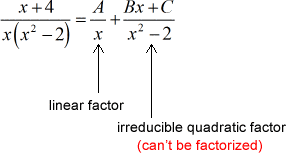
- Get rid of the denominators by multiplying both sides by the [latex]LCD[/latex].

- Cancel out the common factors to clean it up!

- I will distribute, rearrange, and group the coefficients of similar terms.

- Provide a zero placeholder for the [latex]x^2[/latex] on the left side.
Observe the correspondence of the coefficients on both sides of the equation.

- By quick analysis, I know that [latex]C = 1[/latex] and [latex]A = -2[/latex].
Since [latex]A+B=0[/latex] and [latex]A = -2[/latex], therefore [latex]\left( { – 2} \right) + B = 0[/latex] implies [latex]B = 2[/latex].

- These are the correct values of [latex]A[/latex], [latex]B[/latex], and [latex]C[/latex].

- Substitute back the values into the original setup of the partial fraction decomposition, and we’re done!
